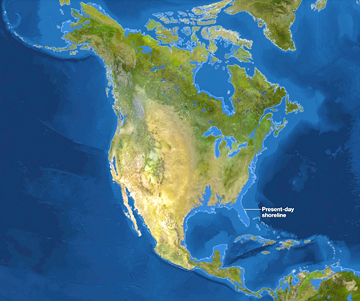
New sets of interactive maps help to visualize both the impact of rising seas on the world’s coastlines and U.S household carbon footprints.National Geographic has posted a set of world-wide interactive maps that show new coastal outlines resulting from the premise of all ice melting and thus raising sea level approximately 216 feet. As noted by the authors:
There are more than five million cubic miles of ice on Earth, and some scientists say it would take more than 5,000 years to melt it all. If we continue adding carbon to the atmosphere, we’ll very likely create an ice-free planet, with an average temperature of perhaps 80 degrees Fahrenheit instead of the current 58.
Continuing on the topic of adding carbon to the atmosphere, University of Berkeley researchers, Christopher Jones and Daniel Kammen, looked at the spatial distribution of U.S. household carbon footprints. The researchers first point out the obvious in that carbon footprints in densely populated areas are typically low because of smaller residences, shorter commutes, and the availability of mass transit. Here’s the catch though – the suburbs have an unusually large carbon footprint and are always in serious need of carbon management. In fact, the footprint is so large that it negates the “green” urban core. As Jones and Kammen summarize:
As a policy measure to reduce GHG emissions, increasing population density appears to have severe limitations and unexpected trade-offs. In suburbs, we find more population- dense suburbs actually have noticeably higher HCF, largely because of income effects. Population density does correlate with lower HCF when controlling for income and household size; however, in practice population density measures may have little control over income of residents. Increasing rents would also likely further contribute to pressures to suburbanize the suburbs, leading to a possible net increase in emissions. As a policy measure for urban cores, any such strategy should consider the larger impact on surrounding areas, not just the residents of population dense communities themselves. The relationship is also log?linear, with a 10-fold increase in population density yielding only a 25% decrease in HCF. Generally, we find no evidence for net GHG benefits of population density in urban cores or suburbs when considering effects on entire metropolitan areas.

